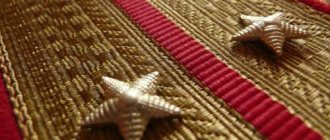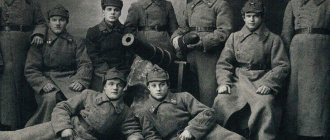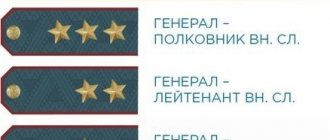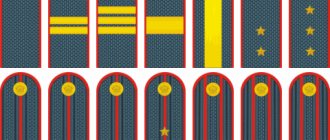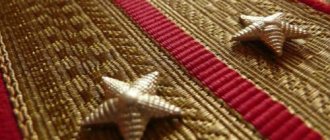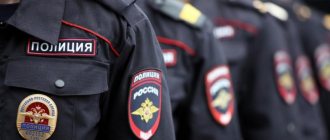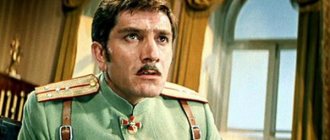The history of the appearance of ranks in the army
For the first time, military ranks in the army appeared in Russia in the 16th century - in the Streltsy army. This continued until the 17th century, when new regiments appeared. In them, many ranks were similar to modern ones, especially among senior and senior officers (majors, colonels, generals).
After the formation of the Russian Empire, in January 1722, Peter I created a table of ranks. Military ranks in it are correlated with courtiers and civilians, divided into 14 classes. Changes were sometimes made to the report card, but in the ground forces the highest rank always remained field marshal general, and in the naval forces - admiral general.
The report card existed before the October Revolution. But the ranks were still used by the White Army during the Civil War of 1917-1922. In 1935, military ranks were reintroduced in the USSR. The titles were both new and pre-revolutionary. They reached their most modern form by 1984. And after the collapse of the Soviet Union, most CIS countries retained this rank system with minor changes.
How did the stars appear on the shoulder straps and what is their meaning?
Even during the times of Tsarist Russia, military personnel differed significantly in appearance from ordinary citizens, since their clothing had its own special insignia. However, during that period of time, shoulder straps as such, much less stars, did not exist. They were not the distinctive insignia of a soldier, as they are now.
As a rule, the appearance of a military man had few elements by which his rank and position in the hierarchy of the army could be judged. More attention was paid not to individual details, but to all military clothing as a whole. Therefore, the status of a serviceman was evidenced by the external cut of clothing, as well as the type of military weapon that the military man always had at hand. Basically, this rule applied to senior and junior officers. Generals, for example, had their own insignia, which distinguished them from military personnel of lower rank.
Reformation in this area occurred during the reign of Peter the Great, who, in his travels abroad, was inspired to change the appearance of the army during Tsarist Russia. The basic attribute initially became breastplates, which looked like a scarf. On it were the heraldic symbols of the army in tsarist times. When the hour of the nineteenth century struck, a new transformation took place in the appearance of the soldier’s clothing, which began to resemble a uniform in appearance, and it was more tail-coated in appearance.
In addition, original headdresses began to appear on the heads of officers, which also became part of the serviceman’s appearance, as a sign of distinction.
After such transformations, it was the turn of the epaulettes, which were the prototype of modern shoulder insignia. There is a significant difference between shoulder straps and epaulettes - the latter never had stars. Therefore, officers were distinguished in this case solely by the color scheme of their epaulettes.
If these are officers of the junior and senior ranks, then the shoulder insignia of tsarist times coincided in shade with the color of the uniform they wore. Generals, as a more privileged class in the military hierarchy, wore gold-colored epaulettes. Another difference between royal epaulettes and modern shoulder straps was that they were a decoration for a military man; they were very catchy and elegant.
Find out: Symbols of the VKS: emblem, coat of arms, flag, insignia from other troops
Often wealthy military personnel had them made to order from pure gold. Modern shoulder straps are more modest, since after the Revolution took place, preference was given to practicality rather than beauty.
Military ranks of Russia
In the Russian Federation, military and ship (naval) ranks are divided. The ship's employees include:
- in the Russian Navy;
- Coast Guard Border Service FSB
- naval forces of the Ministry of Internal Affairs.
Military personnel include:
- to the Ministry of Emergency Situations;
- armed forces;
- FSB;
- FSO;
- ground troops of the Ministry of Internal Affairs;
- Foreign Intelligence Service;
- other ground forces.
Now let's take a closer look at each land military rank. The ranks will go in order - from the lowest to the highest.
Private
The lowest rank in the military service. Assigned to everyone who begins military service. There is nothing on the shoulder straps except golden letters. And on the field uniform there is nothing at all.
The rank and file are the backbone of the army. They can be given orders by senior ranks and the rank and file are obliged to carry them out in a timely manner.
Private corresponds to the ship's rank of sailor.
The position depends on the type of troops and the purpose of the unit. A private can be, for example, an ordinary shooter, driver, radio operator, reconnaissance officer, etc.
A detailed dive into history
As was said, shoulder straps appeared at the end of the 17th century, by the grace of Peter I. The purpose of their use was to hold backpacks and bags of various kinds on the shoulders of grenadiers during long campaigns. Naturally, the innovation was appreciated, which is why this mount began to be used by other branches of the military.
Since 1762, an attempt has been made to make shoulder straps an insignia of regiments and ranks. Different regiments had different patterns of distinctive insignia, and officers and privates, too, by the way, which could not but cause confusion.
Only Paul I thought about changing this misunderstanding a little, canceling one shoulder strap and returning the assignment to hold the bag.
But senior officers begin to wear aiguillettes on their right shoulders. Alexander I decided to completely redesign this distinctive sign, creating a system for assigning colors to the regiment. Encryption is added (indicating the division number with embroidered numbers).
Over the course of 100 years, before the outbreak of the First World War, shoulder straps were gradually added for various military ranks: lieutenants, generals, officers. Accordingly, in August 1914, all military personnel of the active army of the Russian Empire wore shoulder straps.
But in the storm of revolutionary events and during the formation of the young Soviet state, shoulder straps were not used and were replaced by buttonholes. The shoulder straps came to their modern form only at the beginning of 1943.
Corporal
A corporal can be given to any private. They are chosen from the most responsible and distinguished soldiers. They usually occupy the positions of senior drivers, senior shooters, etc. In the absence of other commanders, the corporal takes their place.
The corresponding ship rank is senior sailor.
Their shoulder straps are almost the same as those of privates. But one thin horizontal stripe is added.
The army doesn't really like the rank of corporal. Most likely due to its posthumous appropriation during the war.
Lance Sergeant
This is usually the maximum rank a conscript can receive. To be awarded it, you must have good relations with your superiors and outstanding leadership qualities. Sometimes awarded for outstanding service as a reward. For example, for winning important competitions.
You can also get a junior sergeant by applying for the rank shortly before transferring to the reserve. Usually no one minds as long as you serve well all year.
A contract employee can become a junior sergeant simply by completing special courses.
Junior sergeants are the commanders of a squad, combat vehicle or gun. They must know the regulations perfectly, be able to command personnel and know everything about their subordinates. Their immediate superior is the platoon commander.
The corresponding ship rank is foreman of the 2nd article.
Shoulder straps - 2 horizontal stripes.
Junior command staff
Despite the fact that special ranks are similar to military ones, the rank of corporal is not available in the police. In ascending order, junior command staff are assigned:
- junior police sergeant, an employee must serve in this rank for 1 year, two narrow plates are located across the shoulder strap without axial dividing lines;
- police sergeant, has shoulder straps with three narrow transverse stripes and serves for 2 years;
- senior police sergeant, one wide stripe is placed across the shoulder strap, length of service is 3 years;
- a police sergeant has shoulder straps with one wide stripe located in the center of the shoulder strap, the length of service is not established;
- A police warrant officer wears shoulder straps with one longitudinal red stripe (clearance) and two small stars, 13 mm in diameter, on it, service life is 5 years;
- The senior warrant officer has no restrictions on length of service; he has three stars on his shoulder straps, they are located in the clear, one after the other.
Sergeant
After the service period was reduced to a year, it is almost impossible for conscripts to achieve the rank of sergeant. The only option is to get the rank of junior sergeant as quickly as possible, and by the end of the service, perhaps they will be promoted to sergeant for outstanding service.
A contractor can become a sergeant after 6 months of service in the rank of junior sergeant. But this does not mean that he is obliged to increase his rank after 6 months. Some serve as junior sergeants for several years.
A sergeant, like a junior sergeant, holds the position of commander of a squad, gun or combat vehicle.
The corresponding ship rank is petty officer of the 1st article.
Shoulder straps are 3 horizontal stripes.
What shoulder straps look like
- If you see shoulder straps of a uniform color, on which there is nothing at all, then in front of you is a sailor or private.
- And if there is a badge, this is already a corporal, who corresponds to the ship’s rank of “senior sailor.”
- Two badges indicate a junior sergeant or sergeant major of the 2nd article.
- If the uniform has shoulder straps with three stripes, then their owner is a sergeant or sergeant major of the 1st article.
- One wide stripe indicates a senior sergeant or chief petty officer.
- One wide stripe and one regular one - on the insignia of a petty officer or chief petty officer.
- Two stars on a military man's shoulder straps indicate that he is an ensign or midshipman.
- Three small stars indicate a senior warrant officer or senior midshipman.
- One small star with one gap is depicted on the insignia of junior lieutenants.
- Two small stars and one gap on the lieutenants' insignia.
- Three small stars and one skylight are depicted by senior sergeants.
- Four small stars and one space identify a captain or lieutenant commander.
- Two gaps and one large star located between them mean that you see a major or captain of the 3rd rank.
- Two large stars and two gaps - already a whole lieutenant colonel or captain of the 2nd rank.
- Three large stars and two gaps are the signs of a colonel or captain of the 1st rank.
- One large star with a background of zigzags rather than a solid color is a major general or rear admiral, who are in high command.
- Two stars on a background of zigzags - lieutenant general or vice admiral.
- Three stars on a background of zigzags - Colonel General or Admiral.
- Four stars on the same background - General of the Army or Admiral of the Navy, the highest rank at the moment.
- And finally, one huge star next to the coat of arms of the Russian Federation on a painted yellow shoulder strap belongs to the marshal.
As you can see, there is one less rank in ship ranks, so the highest rank is considered to be Marshal of the Russian Federation . However, at the moment no one holds the rank of marshal; the last marshal was Russian Defense Minister Igor Sergeev, who died in 2006.
It is also worth noting that the ranks of petty officer and chief petty officer have not existed since 2012, although they may still appear in documents to this day.
Perhaps, after reading, someone still wonders: what kind of shoulder straps did the Generalissimo himself have? So, the same as the marshal's. The uniform and distinctive insignia were developed specifically for this highest rank, but were not approved before Stalin’s death, and after these developments turned out to be unnecessary.
In addition, many of you probably know that the ground forces have two types of uniforms: everyday and field, but their distinctive insignia remains the same. The only difference is that on the everyday uniform the letters “VS” are indicated, that is, “armed forces”, but on the field uniform they are absent. However, this will not prevent us from identifying the military rank, right?
Staff Sergeant
To become a senior sergeant, a soldier must serve in the rank of sergeant for at least 6 months.
A senior sergeant in the army holds the position of deputy platoon commander. His responsibilities include many functions. Among them.
- training of soldiers and platoon sergeants;
- maintaining discipline;
- monitoring the cleanliness of the premises;
- conducting a morning inspection;
- assigning soldiers to squads;
- report to the commander about the misconduct, requests, merits and violations of subordinates.
The corresponding ship rank is chief petty officer.
The senior sergeant's shoulder straps have one wide horizontal stripe. It is slightly smaller in size than the three stripes of the sergeant.
How to determine ranks by stars on uniforms of military personnel
shoulder straps are his unique calling card, that is, one glance at the shoulder insignia is enough to understand what rank the soldier has. The stars on the shoulder straps provide enough information about which officer corps the serviceman belongs to.
Sergeant Major
Unlike the sergeant's shoulder strap, the sergeant major has one large vertical stripe.
The best senior sergeants who have served for at least 6 months become sergeant majors.
The corresponding ship rank is chief petty officer.
He is the chief of sergeants and soldiers in his unit. Responsible for the safety of property, the performance of military service by subordinates and their compliance with the regulations.
Warrant officer and senior warrant officer
Starting with the ensign, stars are used instead of stripes on shoulder straps. A warrant officer has 2 stars, a senior warrant officer has 3.
One becomes an ensign after graduating from a special school, bypassing the ranks of sergeant. The training lasts about three years. If you completed military service before this, 6 months. The positions they occupy are often related to property: heads of warehouses, radio stations, etc. If there are not enough officers, they can perform their duties.
The corresponding ship ranks are midshipman and senior midshipman. Since 2009, there has been a project according to which warrant officers will eventually be replaced by sergeants.
Our days and differences
As you can see, a lot has changed since the appearance of shoulder straps to the present day: from their function to their appearance.
Today there are 20 ranks in use, divided into military and naval. The ranks correspond to each other in the hierarchy in the system and have the same symbols on their shoulder straps. For ranks below ensign, insignia are provided, which have only stripes (these are corners) on a uniform background; for ranks above, stars are depicted.
Stars come in different sizes:
- huge - 40 mm;
- large - 22 mm;
- large - 20 mm;
- small - 13 mm.
In addition, there are so-called gaps - these are lines running through the entire shoulder strap, but not across, like stripes, but along the length. One gap is depicted for junior officer ranks, two for senior officers. Generals, warrant officers and lower ranks do not have them.
Ranks are awarded to military personnel for length of service or personal merit.
Lieutenant and First Lieutenant
The rank of lieutenant is awarded to military personnel who graduated from a military school; or those who have a higher civilian education and have completed additional military training.
The rank of senior lieutenant in the army can be obtained if you serve well for some time in the rank of lieutenant.
A lieutenant, like a senior lieutenant, can hold various positions. But most often these are platoon commanders, deputy company commanders or assistant chiefs of staff.
The corresponding ranks for the navy are lieutenant and first lieutenant.
The lieutenant's shoulder straps have a vertical stripe and two small stars on the sides; the senior lieutenant has one star added to the stripe, forming a triangle.
Senior and senior officers
Senior officer ranks include major, lieutenant colonel and colonel. The major has the right to command a training company or be an assistant battalion commander. The lieutenant colonel commands a battalion or serves as an assistant regiment commander.
The colonel has the right to command a regiment, brigade and be deputy division commander. This officer rank was introduced into the armed forces of our country along with a number of others in 1935. In the Navy, the three senior officer ranks of the ground forces correspond to their own ranks of captains of the third, second and first ranks.
The first highest officer rank of the Russian troops is major general. The holder of this rank can command a division (a unit of up to 15 thousand personnel), and also be a deputy corps commander.
Next comes the rank of lieutenant general. Historically, it arose from the position of a senior officer who was the second-in-command of a general. The word "lieutenant" is translated as "deputy". Such a high-ranking officer may command a corps or be deputy commander of an army. Lieutenant generals also serve in military headquarters.
A colonel general may be deputy commander of a military district or command an army. Holders of this military rank hold positions in the General Staff or the Ministry of Defense. Finally, above is the highest military rank of our country's troops - army general. Today, senior officers of individual branches of the military - artillery, communications, etc. can become army generals.
In the naval forces of our country, the highest officer positions correspond to rear admiral, vice admiral, admiral and fleet admiral.
Captain
Captain is an intermediate rank between junior and senior officer. Another star is added to the captain's shoulder straps, forming the shape of the Eiffel Tower.
A captain in the army can hold different positions, depending on the military unit. Usually this is a company commander or the head of some service.
The corresponding ship rank is captain-lieutenant.
All junior officer military ranks are assigned in order. That is, there is no captain who was not a lieutenant.
Shoulder straps for military personnel: appearance and visual designations
The appearance, uniform of shoulder straps of the army and navy of modern Russia, as well as the basic principles of using shoulder straps as the main insignia of military personnel, were generally inherited from Soviet times within the framework of the established system of military ranks. With minor changes, this system continues to operate to this day.
Meaning
The original functional purpose of the shoulder strap on a soldier's uniform was to keep the shoulder strap for the weapon from slipping. Subsequently, the outer surface of the shoulder strap began to serve as a place for placing special insignia (from one to three or four), with the help of which the military rank and military affiliation of their bearer can be easily determined. The system that has developed in Russia provides for the use of the following main elements to indicate military rank on shoulder straps:
- Badges (applied fabric stripes, from 1 to 3 on the shoulder strap). Serve to indicate the ranks of junior command personnel, as well as corporal (senior sailor);
- Pentagonal stars (from 1 to 4 on the chase). Serve to indicate the ranks of warrant officers (midshipmen) and officers;
- Clearances (longitudinal stripes on the shoulder strap fabric - 1 or 2 per shoulder strap). Serve to denote the ranks of junior and senior officers.
In addition, the shoulder straps of senior officers are distinguished by a special (zigzag) fabric relief over the entire area of the shoulder strap.
Colors
The colors of Russian military shoulder straps are designed to reflect the military personnel’s belonging to certain types of the Armed Forces and branches of the military. It is expressed in color:
- The shoulder strap itself is for private and sergeant military personnel;
- Shoulder strap edgings - for military personnel with the rank of ensign and above;
- Clearances on shoulder straps - for junior and senior officers.
The main color of the shoulder straps of the Russian Army is red. For aviation, airborne and space forces, blue shoulder straps are provided. The main color of the Russian Navy shoulder straps is black and gray (formed from small squares arranged in a checkerboard pattern).
Size
The length of standard shoulder straps is 14-16 centimeters, depending on the size of the uniform. The width of the shoulder strap is 6 centimeters. The width of standard strips used on shoulder straps is 5 mm or 15 mm.
The size of the stars on the shoulder straps determines the category of military ranks: warrant officers (midshipmen) and junior officers wear metal gold-plated stars with a diameter of 13 mm, senior officers wear stars with a diameter of 20 mm. General and admiral's stars of the first three levels in these ranks have a diameter of 22 mm, the star on the shoulder strap of the Army General and Marshal of the Russian Federation looks noticeably larger, having a diameter of 40 mm.
Method and tools for fastening stars
The fastening of stars to the shoulder straps of officers, warrant officers and midshipmen is based on the use of wire clips on their back side. To attach the stars, you must perform the following steps:
- Using a ruler, measure the required distance from the edges of the shoulder strap to the center of each star;
- Mark the desired point with a marker.
- Make a hole in this place using an awl.
- Insert the star into the hole and, straightening the antennae, secure it to the shoulder strap.
Major
This rank opens a group of senior officers. Becoming a major is much more difficult than becoming a first lieutenant and captain. The soldier must have an excellent reputation and good relations with his superiors.
Usually holds the position of deputy battalion commander or training company commander.
The corresponding ship rank is captain of the 3rd rank.
The major's shoulder straps are two stripes, and between them is one large star.
Colonel
The last rank of senior officers. Now in Russia the rank of colonel is awarded by order of the Minister of Defense.
Positions held: military unit commander, deputy division commander.
The corresponding ship rank is captain 1st rank.
One star is added to the shoulder straps, forming a triangle. Also, since 2005, colonels and generals wear a special fur hat in winter - a papakha.
Types of shoulder straps
Shoulder straps of the Russian army and navy have varieties depending on the type of uniform of the serviceman: dress or casual. In a number of cases, the conditions for military service in the army require the presence of another type of uniform - field clothing.
Front doors
Sewn shoulder straps are provided on the ceremonial tunic and winter coat for all military personnel of the Russian Armed Forces, and removable shoulder straps are provided on shirts. For privates and sergeants, the color of the shoulder straps on the dress uniform corresponds to their branch of service, with yellow letters “AF” and yellow stripes according to rank. The shoulder straps of warrant officers are khaki, and those of officers are golden. Sailors, petty officers and midshipmen of the Navy wear gray-black shoulder straps on their ceremonial tunic.
Everyday (work)
For privates, sergeants and warrant officers of the RF Armed Forces, everyday shoulder straps are similar to ceremonial ones. Everyday shoulder straps of officers (except for holders of naval military ranks) have a protective color (khaki). Officers with naval ranks of the Navy and midshipmen wear gray-black service shoulder straps with yellow piping on the sides on their everyday tunic and winter coat; on their everyday shirts they wear detachable beige shoulder straps without edging. On the everyday clothes of sailors and foremen, they wear a blue shoulder strap (or blue with a silver edging) with a yellow letter “F” and yellow stripes according to their rank.
Field
The field uniform of Russian military personnel involves wearing removable field shoulder straps of camouflage color. Since 2013, stars and stripes of a protective color have been applied to such shoulder straps at the production stage. No sprocket mounting is required anymore. In addition, officer's shoulder straps of the Russian army of this type do not provide for clearances.
Shoulder straps of the current model for 2022
The current model of shoulder straps for military personnel of the Russian Federation was approved by the Decree of the President of Russia “On military uniforms, insignia of military personnel and departmental insignia” No. 293 of March 11, 2010. Over the past period, the document has been only slightly adjusted (in 2022 and 2022) taking into account amendments to the current legislation. The procedure for wearing shoulder straps (as well as other elements) in combination with various types of military uniforms with accompanying annexes and tables was approved by Order of the Minister of Defense of the Russian Federation No. 300 of June 22, 2015.
Since 2010, instead of sewn-on hexagonal shoulder straps with a trapezoidal upper edge, sewn-on quadrangular shoulder straps with a beveled upper edge have been introduced for some forms of ceremonial and everyday uniforms. The detachable shoulder straps are left hexagonal with a trapezoidal top edge.
For ceremonies and various special occasions, epaulettes of a special design are quite widely used - for example, slightly trapezoidal, with triangular-shaped patches, as well as removable epaulettes of white color.
Major General
To receive the rank of general, you must graduate from the General Staff Academy.
The major general is usually the commander of a division (approximately 15,000 men).
The corresponding ship rank is rear admiral.
Senior officers have no stripes on their shoulder straps and have a special relief applied to them. The stars are no longer attached separately, but are embroidered directly on the shoulder straps. The major general has one big star.
Senior management. Generals' shoulder straps
Many people asked in the comments to supplement the article and add general's shoulder straps. Fair point. Although, of course, the general will not stop you on the street, but for general development you need to know what his shoulder straps look like:
As you can see, they differ from regular shoulder straps due to their unusual shape. Let's list what titles are presented here (from left to right):
- Major General of Police;
- Lieutenant General of Police;
- Colonel General of Police;
- General of Police of the Russian Federation;
Now you know everything about the ranks of modern police. Share the link to this article with your friends, it will be useful to them.
Comments:
- Pom at - 07/09/2013 16:27
But the general won’t stop you, he has nothing to do - stop cars on the roads)
Tina — 07/20/2013 20:08
Are there people who don’t know this? Wind.8 is a problem to master :))) for a pensioner
998909120316 — 06.11.2013 00:44
998909120316 — 06.11.2013 00:45
and the general? and the major general? and the lieutenant general? and the general colonel?
Martin — 06/18/2014 23:21
No, empty shoulder straps are a private and a corporal is a junior sergeant, but with 1 stripe and not 2
Alina — 09.15.2014 13:03
There are no corporals in the police, that is
Rooster - 01/20/2015 19:32
ZIBIIIIIS
